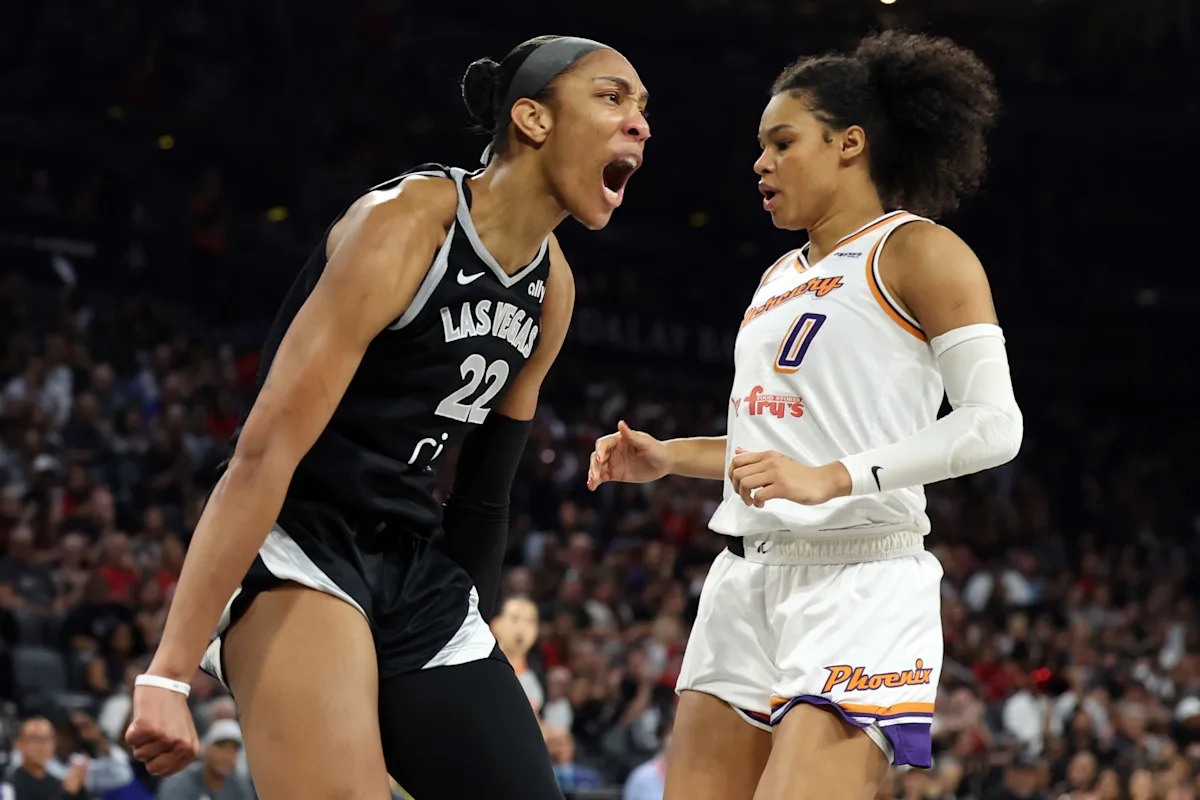
LAS VEGAS — If you want wholesome content, look no further than the postgame press conference following the Las Vegas Aces’ 91-78 Game 2 victory over the Phoenix Mercury on Sunday.
It was essentially the “Sorry to Bother You” scene in real time. A’ja Wilson, who dropped an efficient 28 and 14 in the contest, was effusive in her praise of star wing Jackie Young. At one point, Wilson saluted the journey and growth of Young, highlighting the unexpected shift to point guard earlier in her career and her eventual development as a playmaker and (pull-up) shooter. At another, Wilson simply acknowledged to Young, “You did some nasty stuff today, that’s crazy.”
Advertisement
[Yahoo Sports TV is here! Watch live shows and highlights 24/7]
Young, who set a Finals record with a 21-point third quarter en route to a franchise Finals record 32 points, returned the favor. She called it “a blessing to play with the best player in the world,” highlighting Wilson’s work ethic and the level of dominance she displays despite “getting doubled and triple-teamed.”
It was a loud, 60-point performance for the league’s best duo — a necessary one for the Aces to take a 2-0 series lead as we shift to Phoenix for the next two games.
Much like the first edition, it’s time to dig into a major theme and other takeaways from Game 2.
Advertisement
Let’s dig in, shall we?
A’ja Wilson had plenty to shout about in Game 2 of the WNBA Finals on Sunday. (Photo by Ian Maule/Getty Images)
(Ian Maule via Getty Images)
The Big Picture: If it ain’t broke, don’t fix it
We will circle back to the “how” of the Young-Wilson performance, but I found myself dismayed by the offensive process of the Phoenix Mercury.
The first half of Game 1 saw a heavy focus on Alyssa Thomas spearheading ball screens, often targeting the Aces’ guards (particularly Dana Evans) and generating fruitful shots at the rim and beyond the arc.
Adjustments came in the second half for the Aces, tasking their guards to play closer to the level of screens to take away Thomas’ runway. They also limited the pick-and-roll volume altogether by deploying a zone defense.
Advertisement
In Game 2, the Mercury changed their approach. Thomas didn’t log her first initiated pick-and-roll until the 5:16 mark of the first quarter. She ran her first one with Monique Akoa Makani as the screener, an incredibly successful pairing in Game 1, shortly after (4:50 mark). She’d run two more in the quarter, then two more in the game after that.
After initiating 18 pick-and-rolls in Game 1, with the Mercury generating a whopping 1.13 points per possession on those trips, Thomas initiated six in Game 2.
A few factors went into the low volume, the Aces’ tweaked game plan and execution chief among them. They stuck with the higher meeting point they went to in the second half of Game 1; both Evans and Jewell Loyd (tremendous defensive game overall) did a good job of containing the initial bump of Thomas.
In light of Thomas getting into foul trouble — she picked up her third around the 3:30 mark of the second quarter — it’s understandable to be wary of Thomas picking up an offensive foul on one of her drives.
Advertisement
There’s also the matter of the Mercury searching for more balance in the half-court. The Thomas-led ball screens were undoubtedly successful in Game 1, but you could argue that it was their only trigger that led to consistently good looks. The second half of that game was a loud example of how quickly that dynamic can flip on its head, and how lost an offense can be without effective, comfortable counters to lean on.
Kahleah Copper saw her off-ball activity rise, for example. After receiving seven off-ball screens in Game 1, that total rose to 18 in Game 2. Their stagger setup, where Copper starts in a corner and receives a pair of screens before attacking, has been a common, successful alignment for them. Juicing that volume isn’t inherently bad.
Even with that context, I don’t think the answer should’ve been going away from the Thomas-led ball screens almost entirely. The Aces deserve credit for being sturdier against it, but there was room for the Mercury to press the issue, to make those guards prove they’re really up for the challenge.
Taking three bumps against Thomas is one thing; how are you feeling after taking five? Seven? Eight?
Advertisement
“It was probably more ‘us’ than how they decided to guard [the AT pick-and-roll],” Mercury head coach Nate Tibbetts told Yahoo Sports when asked about Thomas’ lower pick-and-roll volume.
“I don’t know how many times we got to it, but not enough, right, with the success we had in Game 1. It’s something we’ll take a look at moving forward.”
To that end, those ball screens were almost exclusively run in the middle of the floor and without much action before it. There could be room to explore the action with a different spacing alignment (empty side, for example), or with an off-ball screen of some sort happening before the pick-and-roll. These are things I expect the Phoenix coaching staff to explore ahead of Wednesday’s Game 3.
Other takeaways
-
Circling back to Young and Wilson combining for 60 points, whew, did they look comfortable. In Wilson’s 13-point second quarter and Young’s 21-point third, they were both able to shake loose against a backpedaling Mercury defense because of the stops and turnovers they were able to force. Beyond that, it’s worth noting how comfortable they’re beginning to look in the pick-and-roll together. They were the league’s best duo during the regular season (1.11 PPP); the Mercury can’t afford for them to start performing like it in this series.
-
First and foremost, I hope Satou Sabally’s ankle is good to go for the rest of the series. She said she was fine when asked about it after the game, so we’ll roll with that until proven otherwise. The Mercury certainly need a better, more consistent version of Sabally moving forward, but they’ll be more likely to get it if they scheme up easier-to-read opportunities for her. A quick example: of the eight off-ball screens Sabally received in Game 2, only one of them led to a touch inside the 3-point line. In Game 1, five of her seven off-ball screens led her inside, like the first play here. Sabally has to take ownership of some of her decision-making, but it’s also on the staff to put her in more threatening positions. With two days off before Game 3, I trust that it’ll have a better plan in place.
Advertisement
-
Can we just pause for a moment and acknowledge Chelsea Gray’s defense? She logged three steals and three blocks in Game 2, and was generally a presence to account for otherwise. She’s had to play a ton of 4 this season, and she’s largely been up for the challenge. It’s fun watching legends of the game essentially reinvent themselves on the fly like this. Through two games, the Mercury just haven’t been able to turn Gray into any sort of liability.
-
I thought Akoa Makani mostly handled an uptick in pick-and-roll usage well (13 in Game 1, 16 in Game 2). The Mercury generated 1.2 points per possession on those trips, an elite number. It was a nice mixture of looking for others (7 assists, 1 turnover) and looking to turn the corner and attack or pull up. With that said, the 0-of-3 clip from 3 certainly hurt, and in general, the Aces are getting more audacious with their help whenever she’s spaced. They’re going to need her shotmaking and playmaking and defense in Phoenix; tough ask for a rookie, but that’s what the Finals require.
-
The only Mercury rotation player to finish with a positive plus-minus in Game 2 was, you guessed it, Natasha Mack (+4 in 19 minutes). With DeWanna Bonner a combined 2-of-9 from 3 in the Finals, I wonder if we ever reach a point where the Mercury prioritize Mack’s size, rebounding and defense over the spacing threat of Bonner. There are downsides to that decision — the Aces become a more ambitious help defense when Mack’s on the floor, for example — but it’s worth considering.
#Morning #Aces #WNBA #Finals #Game #dominance #impressive #Mercurys #change #approach #curious





